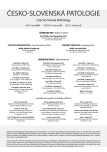Giant cell-rich lesions of bone and their differential diagnosis
Authors:
Iva Zambo 1; Lukáš Pazourek 2
Authors‘ workplace:
I. patologicko-anatomický ústav, FN u sv. Anny a LF MU, Brno
1; I. ortopedická klinika, FN u sv. Anny a LF MU, Brno
2
Published in:
Čes.-slov. Patol., 53, 2017, No. 2, p. 61-70
Category:
Reviews Article
Overview
Giant cell-rich lesions form a heterogeneous group of reactive and truly neoplastic processes with diverse clinical presentation and biological behavior. Common to all of them are variably numerous multinucleated osteoclast-like giant cells and the presence of mononuclear stroma. Based on the histological picture alone it is sometimes impossible to reliably distinguish certain tumors from each other. The pathologist has to know the patient´s age, the exact localization, tumor growth dynamics and its radiographic characteristics. Secondary reactive changes occur frequently and these can completely alter the morphology of the lesion and thus overshadow the underlying neoplasm. Reparative changes in a pathological fracture may histologically mimic primary bone malignancy. Immunohistochemistry helps only in select cases and molecular genetic methods still have very limited utility for the diagnosis of giant cell-rich tumors. It is necessary to correlate the microscopic features of the lesion with clinical and radiological findings. A correct diagnosis is of paramount importance for proper treatment and prognosis.
Keywords:
giant cell tumor – non-ossifying fibroma – chondroblastoma – aneurysmal bone cyst – giant cell reparative granuloma – giant cell-rich osteosarcoma
Sources
1. Czerniak B. Dorfman and Czerniak´s bone tumors (2nd edn). Philadelphia: Elsevier; 2016: 246-1085.
2. Fletcher CDM, Bridge JA, Hogendoorn PCW, Mertens F, eds. WHO classification of tumours of soft tissue and bone (4th edn). Lyon: IARC; 2013: 262-374.
3. Liao TS, Yurgelun MB, Chang SS et al. Recruitment of osteoklast precursors by stromal cell derived factor 1 (SDF-1) in giant cell tumor of bone. J Orthop Res 2005; 23(1): 203-209.
4. Shooshtarizadeh T, Rahimi M, Movahedinia S. P63 expression as a biomarker discrimiating giant cell tumor of bone from other giant cell-rich bone lesions. Patlogy – Research and Practise 2016; 212(10): 876-879.
5. Hammas N, Laila C, Youssef ALM et al. Can p63 serve as a biomarker for giant cell tumor of bone? A Morroccan experience. Diagnostic Pathology 2012; 7: 130.
6. Lee CH, Espinosa I, Jensen KC et al. Gene expression profilig identificates p63 as a diagnostic marker for giant cell tumor of bone. Mod Pathol 2008; 21(5): 531-539.
7. Behjati S, Tarpey PS, Presneau N, et al. Distinct H3F3A and H3F3B driver mutations define chondroblastoma and giant cell tumor of bone. Nat Genet 2013; 45(12): 1479-1482.
8. Kinkor Z, Svoboda T, Grossman P, Bludovský D, Heidenreich F, Švec A, Mečiarová I. Difúzní obrovskobuněčný tumor šlachových pochev krční páteře s destrukcí obratle C6 – kazuistika. Cesk Patol 2016; 52(4): 218-221.
9. Bakle M, Schremper L, Gebert C et al. Giant cell tumor of bone: treatment and outcome of 214 cases. J Cancer Res Clin Oncol 2008; 134(9): 969-978.
10. Gaston CL, Bhumbra R, Watanuki M et al. Does the addition of cement improve the rate of local recurrence after curettage of giant cell tumours in bone? J Bone Joint Surg Br 2011; 93(12): 1665–1669.
11. Kivioja AH, Blomqvist C, Hietaniemi K et al. Cement is recommended in intralesional surgery of giant cell tumors: a scandinavian sarcoma group study of 294 patients followed for a median time of 5 years. Acta Orthop 2008; 79(1): 86–93.
12. Klenke FM, Wenger DE, Inwards CY et al. Giant cell tumor of bone: risk factors for recurrence. Clin Orthop Relat Res 2011; 489(2): 591–599.
13. López-Pousa A, Martín Broto J, Garrido T and Vázquez J. Giant cell tumour of bone: New treatments in development. Clin Transl Oncol 215; 17(6): 419-430.
14. Chawla S, Hnshaw R, Seeger L et al. Safety and efficacy of denosumab for adults and skeletally mature adolescents with giant cell tumour of bone: interim analysis of an open-label, parallel-group, phase 2 study. Lancet Oncol 2013; 14(9): 901-908.
15. Thomas D, Henshaw R, Skubitz K et al. Denosumab in patients with giant-cell tumour of bone: An open-label, phase 2 study. Lancet Oncol 2010; 11(3): 275-280.
16. Branstetter DG, Nelson SD, Manivel JC et al. Denosumab induces tumor reduction and bone formativ in patiens with giant-cell tumor of bone. Clin Cancer Res 2012; 18(16): 4415-4424.
17. Gaston CL, Grimer RJ, Parry M et al. Current status and unanswered questions on the use of Denosumab in giant cell tumor of bone. Clin Sarcoma Res 2016; 6(1): 15.
18. Mallet JF, Rigault P, Padovani JP et al. Non-ossifying fibroma in children: a surgical condition? Chir Pediatr 1980; 21(3): 179-189.
19. Colby RS, Saul RA. Is Jaffe-Campanacci syndrome just a manifestation of neurofibromatosis type 1? Am J Med Genet 2003; 123A(1): 60-63.
20. Kurt AM, Unni KK, Sim FH, McLeod RA. Chondroblastoma of bone. Hum Pathol 1989; 20(10): 965-976.
21. Rosenberg AE and Nielsen GP. Giant cell containing lesions of bone and their differential diagnosis. Curr Diagn Pathol 2001; 7(4): 235-246.
22. Bertoni F, Bacchini P, EL Staals EL. Giant cell-rich osteosarcoma. Orthopedics 2003; 26(2): 179-181.
23. Ta HT, Dass CR, Choong PF, Dunstan DE. Osteosarcoma treatment: state of the art. Cancer Metastasis Rev 2009; 28(1-2): 247-263.
Labels
Anatomical pathology Forensic medical examiner ToxicologyArticle was published in
Czecho-Slovak Pathology

2017 Issue 2
Most read in this issue
- Myxoid tumors of soft tissues
- Giant cell-rich lesions of bone and their differential diagnosis
-
Hybrid peripheral nerve sheath tumors:
A review - Mature teratoma of the uterine corpus: A case report
